Thermostat for underfloor heating: principle of operation + analysis of types + installation tips
Thermoelements of the warm floor do not come in contact with the air they are heating, so the temperature in the room is controlled by an external device - the thermostat. The size of electricity consumption depends on its functionality. Agree, for a balanced purchase, you should understand the characteristics and capabilities of the device.
We will talk about how to buy the most suitable thermostat for a warm floor. The article we presented describes its varieties that differ in the type of control, the option of fixing the temperature of the device, and the method of installation. Tips are provided to facilitate the selection of the optimal model.
The content of the article:
The principle of operation of the thermostat
The temperature controller is designed to control the operation of the warm floor system (STP). It consists of an adjustment device and one or more sensors. Information from them is taken into account when turning on and off thermal mats.
Thanks to the operation of the device in the rooms, an even temperature is maintained and energy consumption is minimized.
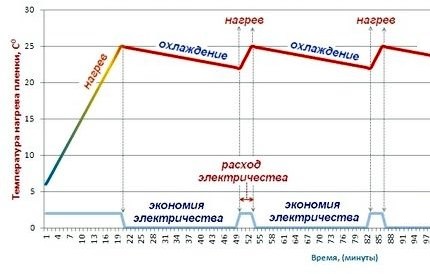
Thermostats are easy to use, even teenagers can use them. At the same time, the STP operating mode can be changed several times a day, without fear of breakdown or premature failure of the equipment.
The minimum temperature can be set separately for each room. In addition, some models allow programming the operating mode of the device during the day.
Types of devices by type of control
The regulation of the STP is carried out by a special device, which is usually hung on the wall. It has the dimensions of a standard key switch and can be equipped with a mechanical, electronic or programmable interface.
Mechanical without electronics
The mechanical temperature controller does not provide for the presence of electronic components in its design. Electrical wires to the STP go directly through the device, which adds problems during its installation.

The function of the temperature sensor in a mechanical regulator is usually performed by a bimetallic plate, which in the cold state closes the contacts of the heating mats. When the temperature in the room increases, it bends and disconnects the electrical circuit, as a result, heat generation stops.
The control interface is represented by a wheel, rotating which you can adjust the temperature in the room.
Such a device device has its advantages:
- Low price.
- Simplicity of operation.
- Ability to work at low temperatures.
- Reliability.
- Independence from voltage drops.
- Long service life.
- Auto power on after a power outage.
The simplicity of a mechanical temperature controller determines its disadvantages, which can be critical:
- Minimal functionality.
- The lack of remote control.
- Big error.
- The presence of clicks when bending a bimetallic plate.
Despite its simplicity, mechanical temperature controllers are firmly held in the consumer market due to their high reliability, simplicity and interchangeability.
With electronic gear
Appearance of electronic temperature regulators for electric underfloor heating may not differ from mechanical devices. The main difference lies in the internal filling of the device.

Electronic floor heating controllers consist of the following components:
- Body.
- Control chip.
- Built-in or external temperature sensor.
- An electronic key for turning on and off the power supply to the heating mats.
The temperature in the electronic temperature controllers can be set using the touch screen, buttons, control wheel or a combination of these methods.
Some models support multi-zone temperature control, in which several isolated zones of the warm floor with their sensors are independently connected to the control chip.
The advantages of electronic devices include:
- The ability to install a remote temperature sensor in any place of the room.
- Existence of the display displaying the current and set temperature.
- Possibility of multi-zone heating control.
- The accuracy of the temperature sensor to fractions of a degree.
- Indication in case of error or breakdown.
- Possibility of completing with a remote control unit.
The disadvantages of the electronic temperature controller are mainly due to the presence of a microcircuit.
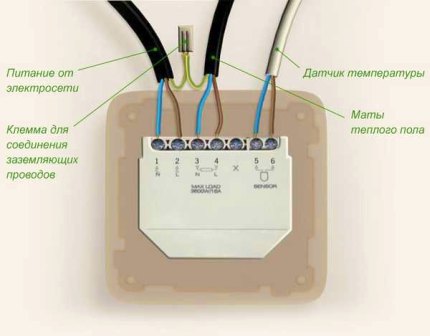
The disadvantages include such characteristics:
- Dependence of the stability of the control microcircuit on voltage drops.
- Failures in the settings during a short power outage.
- Higher price than mechanical appliances.
Mechanical temperature controllers are only 15-25% cheaper than their electronic counterparts, therefore, in the absence of voltage drops in the network, the choice between these two types of devices is determined mainly by their appearance.
Spectacularly looking luminous displays are often the main motivating factor when buying a particular model of thermostat.
Programmable electronic devices
The main difference between programmable thermostats and conventional electronic devices is the advanced functionality of the control chip. This type of instrument allows you to adjust the different temperature in the rooms depending on the time of day.
As a result, users get a huge advantage in the form of energy savings by reducing air heating in an empty house
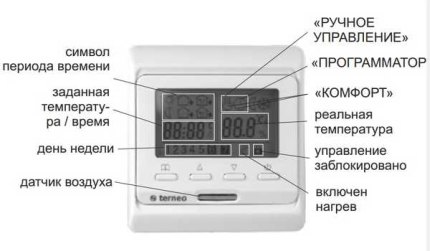
In programmable thermostats, the function of remote control from a smartphone via Wi-Fi can also be provided.
The disadvantages of such devices include the high cost and complexity of the settings in the absence of skills in handling equipment. Otherwise, the pros and cons of programmable thermostats are the same as conventional electronic ones.
With remote control unit
In electronic and programmable thermostats, internal components can be spaced into two blocks: the main and mobile. Electric cables are suitable for the main box and wired temperature sensors are connected. It can be located in any remote place in the room, which facilitates installation work.
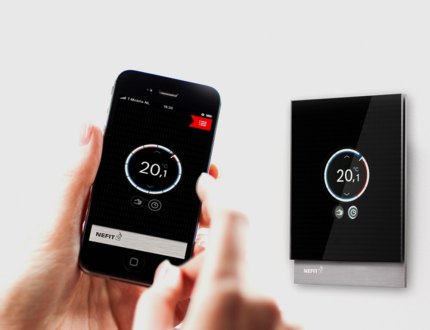
A battery-powered mobile unit is used as a control panel. It can lie on a table or hang on a wall. Additionally, external temperature sensors that measure the ambient temperature can be installed in the consoles. Such devices are convenient in that they allow you to hide the adjustment mechanism from small children.
Types of temperature sensors for underfloor heating systems
The operating mode of the STP heating elements directly depends on the correctness of the temperature measurement by thermal sensors. They can be integrated into the housing of the control box or placed remotely.
Thermal sensors come in four types:
- To determine the air temperature.
- Infrared measuring floor heating at a distance.
- To determine the surface temperature of the floor by contact.
- Combined.
An air heating sensor is usually integrated in a temperature controller or its mobile unit. It is used when the underfloor heating is the main heating system. The main requirement for its location is the presence of natural air circulation around the device.
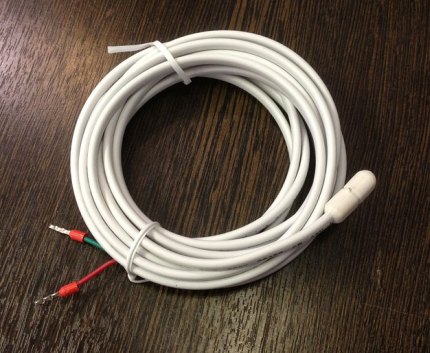
Infrared floor temperature meters can be built into the thermostat housing or placed as a separate unit. The main requirement for their installation is the absence of obstacles between the sensor and the floor. The distance between the device and the analyzed surface should be at least 30 cm.
Contact type temperature sensors look like a long wire with a thickening at the end. On the one hand, they are connected to the temperature control unit, and on the other, they are placed in a special long corrugated pipe under the floor. This installation feature makes it easy to replace a broken sensor with a new one.
The advantage of underground placement is the ability to multi-zone control of floor temperature within the same room. Typically, such sensors are installed when installation of underfloor heating as an additional heating system.
Several sensors can be connected to the thermostat, but such a scheme is mainly used as part of an integral set of equipment.
Rules for installing the temperature controller
It is necessary to bring electric cables and wiring from temperature sensors to a thermostat suspended on a wall.To do this, the corresponding grooves are made in the slab - strobes. In them, wires are laid to the electrical panel and to the floor.
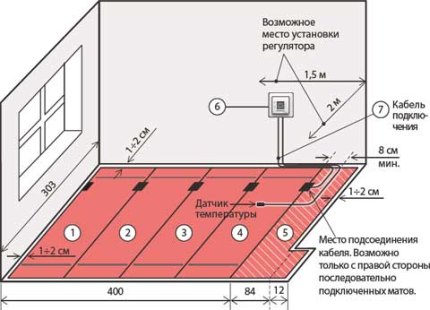
If the equipment is installed in a room with high-quality interior decoration, then you can use overhead appliances and lead cables over the walls in the boxes.
The following are the basic rules, compliance with which is necessary when installing thermostats:
- It is better to place the adjusting device at a distance of 40-170 cm from the floor, unless otherwise provided by the instructions. If you have a mobile control panel, the main box can be installed in any convenient place.
- The main functions of the floor temperature sensor are the prevention of overheating of the floor covering and the comfort of the legs, but not the thermal control of the air in the room.
- In humid rooms it is allowed to use thermostats with appropriate protection against ingress of water.
- When installing the device in a wall, a mounting box made of non-combustible materials is used.
- Wires from the regulator to the heaters of a warm floor with a power of more than 1 kW must be conducted in hollow heat-resistant tubes.
- The floor temperature sensor must be located between the heating elements and at least 50 cm from the walls.
- When you turn on the device for the first time, the minimum operating temperature specified in the instructions must be taken into account.
- Wiring to the terminals of the thermostat must be carried out exclusively according to the scheme specified in the manual.
- The installation of the thermostat begins only after the final installation of the heating elements on the floor in order to correctly calculate the length of the wires.
- When filling the floor with mortar, it is necessary to insulate the end of the tube with the temperature sensor well.
- Before pouring the mortar on the floor, it is necessary to check the operability of all elements of the system.
- The heating mats are necessarily grounded, and an RCD is installed in front of the thermostat.
Compliance with these rules will protect residents from electric shock, the house from fire, and equipment from premature failure.
Instrument Selection Tips
When buying a thermostat, you need to know certain nuances in order to pay only for the necessary functions and ensure the longevity of work floor heating system and the device itself.
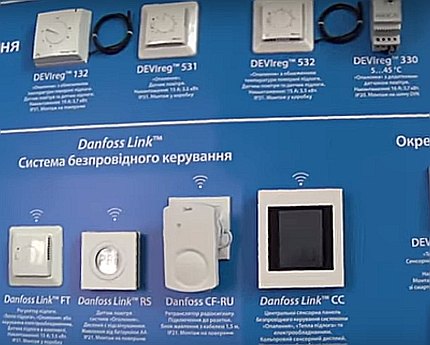
These selection features include the following rules:
- For heating small rooms, an inexpensive mechanical or electronic temperature controller with an internal air temperature sensor is suitable.
- It is rational to buy a programmable thermostat when it is necessary to have multi-zone temperature control, as well as to save electricity when there are no residents at home in the daytime.
- The temperature regulator must correspond to the maximum power of the heating elements with a margin of 25-30% in case of operation with reduced voltage.
- For houses with wooden interior decoration, only overhead boxes of thermostats are suitable.
Also, when choosing a device, it is necessary to take into account its design performance.
The existing model range allows you to buy not only reliable equipment, but also a thermostat that fits perfectly into the interior of the room.
Conclusions and useful video on the topic
Video clips with reviews of species and examples of the installation of temperature controllers will allow you to better understand their principle of operation and selection criteria.
Video # 1. Classification and principle of operation of temperature regulators:
Video # 2. Detailed setting of the programmable thermostat:
Video # 3. Mounting the floor temperature sensor:
Analysis of various temperature controllers allows us to say that their maximum functionality is not always justified from both a financial and operational point of view. Therefore, this equipment must be selected for each STP separately.
And how did you choose, mount and connect the thermostat for the floor heating system? Share what has become a decisive landmark for you? Please leave comments in the block below, ask questions, publish useful recommendations and photos on the topic of the article.

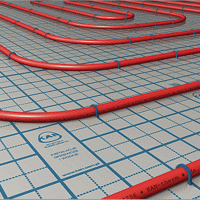 Laying schemes for a warm water floor: analysis of the most effective installation options
Laying schemes for a warm water floor: analysis of the most effective installation options  Mats for underfloor heating: selection tips + styling guide
Mats for underfloor heating: selection tips + styling guide  Pipes for underfloor heating: a comparative overview of all options + design tips
Pipes for underfloor heating: a comparative overview of all options + design tips 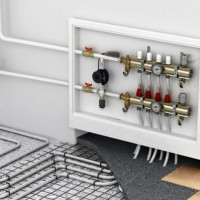 Water underfloor wiring diagram: versions and device manual
Water underfloor wiring diagram: versions and device manual 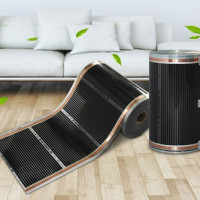 Infrared film for underfloor heating: types of films, how it works, laying rules
Infrared film for underfloor heating: types of films, how it works, laying rules 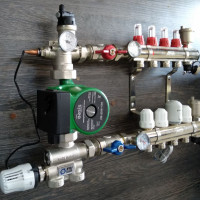 Mixing unit for underfloor heating: installation rules for the distribution manifold
Mixing unit for underfloor heating: installation rules for the distribution manifold  How much does it cost to connect gas to a private house: the price of organizing gas supply
How much does it cost to connect gas to a private house: the price of organizing gas supply  The best washing machines with dryer: model rating and customer tips
The best washing machines with dryer: model rating and customer tips  What is the color temperature of light and the nuances of choosing the temperature of the lamps to suit your needs
What is the color temperature of light and the nuances of choosing the temperature of the lamps to suit your needs  Replacement of a geyser in an apartment: replacement paperwork + basic norms and requirements
Replacement of a geyser in an apartment: replacement paperwork + basic norms and requirements
In my opinion, a mechanical temperature controller is much more reliable than an electronic one. Yes, and understand it easier. At home I installed just such a warm floor. It is very convenient when it is possible to maintain a single heating temperature. Periodically, voltage drops occur in the apartment, the regulator does not respond to them. The only thing that did not take into account the error in the measurements. Is there a difference between electronic and mechanical? I want everything to be as close to the truth as possible.
In general, electronic thermostats are even more reliable than mechanical ones. But specifically to voltage surges, they are more sensitive, because The electronic board may burn out.
I do not agree, there is no difference in reliability. At the same time, the electronic thermostat is much more functional.